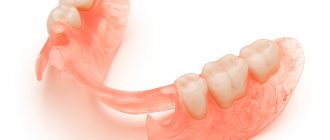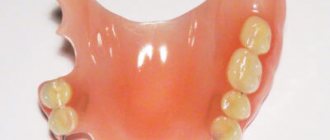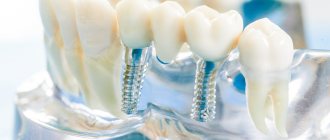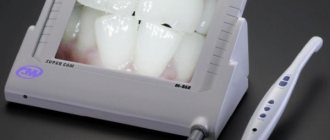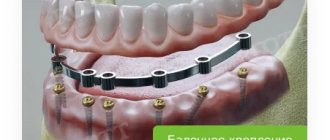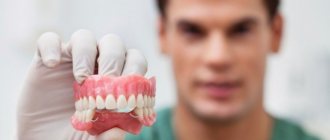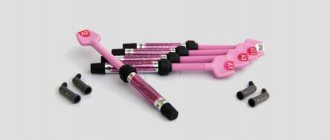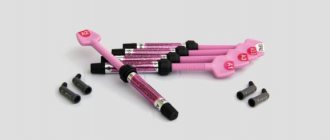Features of removable dentures
Removable dentures are those that can be removed and installed independently without the help of a specialist. The main indication for their installation is the impossibility of implantation or restoration of dental units with bridges.
The type of construction is chosen based on the number of missing teeth, their location in a row and other factors. There is no best removable denture that would be suitable in all cases; everything is strictly individual.
Types of prostheses
Modern orthodontics offers many types of dental restoration. Each method has its own advantages and disadvantages and is used to solve a particular problem. The type of prosthesis and method of prosthetics are selected by the attending physician together with the patient, based on the clinical situation, budgetary capabilities and patient preferences. Orthopedic structures are distinguished by the method of fixation, the material of manufacture, the defect being replaced, and the type of fastenings in the oral cavity.
Classification by method of fixation
Based on the method of fixation, a distinction is made between removable and non-removable structures. A very special type is fixed dentures on implants.
- Removable structures. They can be removed from the mouth independently. They solve the problem of the absence of one or more units in the dentition. Inexpensive and easy to care for.
- Fixed structures are permanently fixed in the oral cavity. They are durable, strong and efficient. They have a higher cost.
- Implantation is the most complex and expensive type of prosthetics. Implants are a multi-component structure that is inserted into the bone tissue of the jaw and replaces the root part of the teeth. On their basis, the restoration of the dentition is carried out.
Classification by material of manufacture
In modern dentistry, many materials have been developed for the manufacture of prosthetic structures. Here are the four main types:
- Plastic structures are made from polymerized acrylic. This lightweight and durable material is inexpensive and available. The lightweight porous structure ensures a tight fit, which significantly reduces the adaptation time. Under heavy loads, plastic prostheses are prone to loosening and are therefore short-lived. Used for temporary use.
- Nylon prostheses are made from soft, hypoallergenic synthetic material. They are secured in the mouth using special clasps. The disadvantage is its short service life. The chewing load is distributed unevenly, which can lead to bite problems.
- Zirconium dioxide structures. Zirconium dioxide is a durable natural mineral, naturally enriched without the presence of synthetic impurities. Used for the preparation of fixed dentures. It has many advantages: it holds the chewing load well, its shade is close to natural enamel, and it has low thermal conductivity. Zirconium dentures are not used to treat severe malocclusions, since a strong crown begins to destroy neighboring teeth.
- Ceramic dentures are made from specially treated ceramics with the addition of lithium disilicate. The crown material is very durable and reliable, its structure is closest to tooth enamel. Ceramic dentures have the highest aesthetics, therefore they are used for prosthetics in the smile area.
Classification of dentures according to the volume of the replacement defect
Depending on the clinical situation, the patient may be indicated for a complete or partial denture:
- Complete dentures are removable or conditionally removable structures used in the absence of all units in the dentition. A complete denture simulates the entire dentition. The base of the prosthesis rests on the gums and helps fix the structure in the oral cavity.
- Partial dentures help restore dentition when several teeth are missing. They imitate a fragment of the dentition, replacing several nearby missing dental units or teeth lost in different parts of the jaw.
Classification of prostheses by type of fastenings
Depending on the method of fastening the prosthesis in the oral cavity, the functional load on the supporting tissues is distributed differently. The following types of orthopedic structures are distinguished:
- Lamellar dentures are a type of removable structures. Effective for partial or complete edentia. They differ in the material of manufacture and the method of attachment in the oral cavity. Attached directly to the mucous membrane.
- Bridges are non-removable structures used in cases where several dental units are missing in a row. They are attached to dental units spaced apart from each other and ground for crowns.
- Supported or clasp dentures are distinguished by a special way of transferring the load: through the supporting teeth, periodontium and mucous membrane. This method is called semi-physiological.
Acrylic removable dentures
Constructions based on acrylic plastic are universal in use, suitable for complete or partial edentia, placed on the upper, lower or both jaws at once, and do not require complex installation. Their main features:
- This is the most budget-friendly type of design; due to its moderate price, it is popular among the older generation. Allows you to quickly replace any number of teeth, even in the absence of supporting units, does not require grinding or injury to healthy teeth.
- They are made individually based on impressions of the patient’s jaw.
- The material is quite durable and can withstand heavy loads, but if you abuse excessively hard products, the product may break.
- Visually, they represent an artificial jaw, which is fixed in the mouth due to the vacuum effect. You need to place it on the teeth and press to release the air. For additional fixation, use a special cream.
- The key to strong fixation is the tight fit of the structure to the prosthetic bed so that air does not get inside. Acrylic prostheses on an individual impression tray can provide such a fit.
- If it breaks, it can be repaired, which will be cheaper than making a new one.
- Average service life is 3-3.5 years. As the jaw bone atrophies, replacement is required.
To say that these are the best removable dentures would be an exaggeration. In addition to the fact that they sometimes fall out, the structures can rub the gums and interfere with diction, requiring a long time to get used to.
And when replacing the upper jaw with prosthetics, the base of the prosthesis completely covers the palate. This provokes a temporary disturbance in the articulation of speech and impairs taste sensitivity, since the taste buds located on the palate are closed.
What is the price?
Prices for palateless dentures vary greatly depending on various factors. The cheapest - clasp dentures with clasp attachments - cost from 35,000 rubles for installation (for one upper removable denture without a palate). Next come clasp dentures with telescopic crowns - from 45,000 rubles, and the most expensive of the clasp ones - products with fasteners on attachments, their price starts from 55,000 rubles. Prosthetics using a Quadrotti product will cost at least 30,000 rubles. And the cost of installing the latest sandwich-type dentures without a palate is already significantly higher. Installing such a prosthesis on attachments will cost at least 55,000 rubles for one removable upper denture of teeth without a palate. Prosthetics for both jaws will cost from 100 thousand rubles - the cost is not the smallest, on the other hand, a complete removable denture without a palate on implants will cost even more.
The indicated prices for prostheses include consultation with a specialist, diagnostics, taking impressions, preparing supporting teeth for prosthetics, manufacturing, fitting, fitting and fixation of the prosthesis.
Note!
During treatment, you may need to spend on additional services - for example, removal of damaged teeth or implantation, if prosthetics cannot be performed without it. Discuss all possible nuances with your doctor in advance in order to adequately assess the situation and plan expenses.
Partial plastic prosthetic systems
For multiple missing teeth in a row, acrylic partial dentures are suitable. They are not fixed by vacuum, but by wire clasps that wrap around the support units. This ensures a strong hold, a tight fit and an even chewing load.
But when installed in the frontal area, the clasps will be visible, creating an aesthetic defect. Therefore, for the “smile zone”, nylon or clasp systems are preferable.
Nylon prosthetic structures
An alternative to plastic are systems made of nylon: soft, flexible, elastic, do not rub or injure the gums.
This is an excellent option for partial dentures and the best removable dentures used when several teeth are lost in a row or in different areas of the jaw.
They are attached to the supporting teeth with nylon clasps and are almost invisible. They completely imitate natural fabrics and do not cause psychological discomfort.
In cases of complete edentia, they are not used because they cannot provide reliable fixation. In addition, nylon is a soft elastic material; under increased chewing loads it deforms. For completely edentulous patients, acrylic suction cup systems are preferable.
Features and production
How is a removable sandwich denture different from a regular one? This cover-type design does not block the sky, that is, the fabrics remain open, which increases comfort and eliminates many unpleasant sensations. Support requires lateral teeth or roots on which the prosthesis is fixed, and it is not necessary to remove it at night. No metals or alloys are used in manufacturing, which is also an advantage.
But the method also has contraindications:
- mental disorders;
- oral diseases;
- allergic reactions to the materials used;
- There are no supporting roots or teeth, and there is also no possibility of installing four implants.
Prostheses are made by a doctor with appropriate qualifications. During the initial examination, the condition of the oral cavity and the possibility of using the technique are determined. If necessary, a panoramic photo will be taken. The remaining units are then treated and an impression is made using a dental tray. The dental technician makes a design, which, after fitting, is given to the patient along with care recommendations.
Butterfly dentures
If one or two teeth are missing in a row, butterfly dentures made of acrylic plastic are suitable:
- are installed on the sides of missing teeth and do not require grinding of supports;
- easy to use, ensure uniform distribution of chewing load;
- strong and durable;
- easy to take off and put on;
- imitate natural fabrics and are invisible.
For replacing 1-2 units, these are undoubtedly one of the best removable dentures.
They are not suitable for restoring the outermost units in a row, since fixation requires two supports on either side of the defect.
Acry-free removable prosthetics systems
When analyzing which removable dentures are better, one cannot help but consider the “Acry-free” designs based on improved acrylic plastic.
The material does not contain methyl methacrylate, therefore it is more flexible and soft than acrylic. Dentures are comfortable to wear and are used in cases of complete or partial absence of teeth.
Experts and patients note the high aesthetics of Acri-free systems - they perfectly imitate natural teeth and gums.
They are fastened with clasps made of translucent material, are invisible and do not cause inconvenience.
The main disadvantage is the high price.
Clasp removable dentures
The answer to the question “which removable dentures are the best for partial dentures” is clear: clasp dentures.
They consist of a metal frame and a nylon or plastic base with artificial teeth. They are smaller in size and do not cover the palate, so they do not create discomfort when worn and do not impede articulation.
They can withstand heavy loads and look like natural teeth.
Distribute the chewing load evenly between the supporting teeth and gums, preventing atrophy and tissue loss.
They are fixed in the mouth using nylon clasps or micro-locks, which are placed on the supporting teeth and snap into place after the prosthesis is installed. The second option is preferable because it guarantees maximum fixation, and the micro-locks are absolutely invisible and the aesthetics of the smile are not affected.
Suitable for replacing any number of teeth, including the outer ones in a row.
Advantages and disadvantages
New generation dentures without a palate have a number of obvious advantages:
- No nausea due to a foreign body in the mouth
- Correct distribution of chewing load
- No need to remove the prosthesis at night
- Comfort in use
- Excellent hold
- No increased salivation
- Opportunity to eat well
- No speech problems
- Reasonable price
- Universal design
- Good level of aesthetics
- Splinting effect (allows people with periodontitis to wear the structure)
Modern removable dentures without a palate also have disadvantages: they can only be fixed to abutment teeth, and this will require their preparation; after installation, they require careful daily oral hygiene - you need to clean the structure with a special brush and paste 2 times a day, and rinse your mouth after every meal. Please also note that new generation palateless dentures are more expensive than traditional ones.
Dentures without palate
This type includes clasp structures that do not have a palate, and sandwich dentures. These are new generation prosthetic systems that combine elements of different designs.
They are only suitable for partial dentures, as they require supporting teeth.
Sandwich dentures consist of a solid acrylic frame with artificial teeth, and a thin elastic polyurethane part, which is worn over the patient’s own teeth and fixes the entire structure.
Due to the absence of a palate, sandwiches do not change the taste of food, do not interfere with speech, are comfortable and are not tactile. But they unevenly distribute the chewing load; when chewing solid food, unpleasant or painful sensations are possible. Plus, their level of fixation is not high enough.
To learn more about removable dentures, schedule a consultation with the clinic online or by phone!
Main contraindications
- Inflammatory diseases in the oral cavity that prevent the installation of removable dentures of the plate type or without a palate.
- Gum diseases. In this case, prosthetics with new generation sandwich structures are possible after treatment.
- Individual cases of malocclusion. Requires correction with braces.
- Caries and other diseases of supporting teeth, in which removable sandwich dentures without a palate are contraindicated.
- Impossibility of installing implants.
- Mental illnesses and other general contraindications that do not allow prosthetics with removable sandwich structures of the new generation while fully ensuring the safety of the patient.
